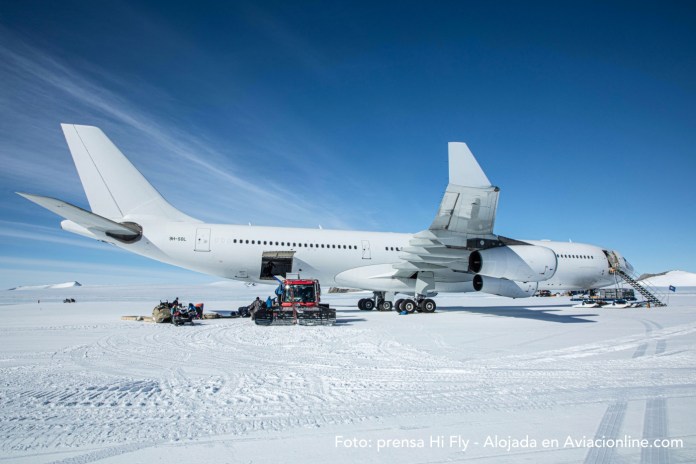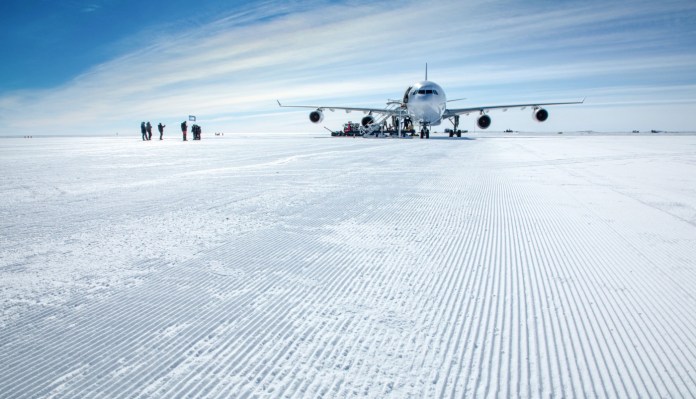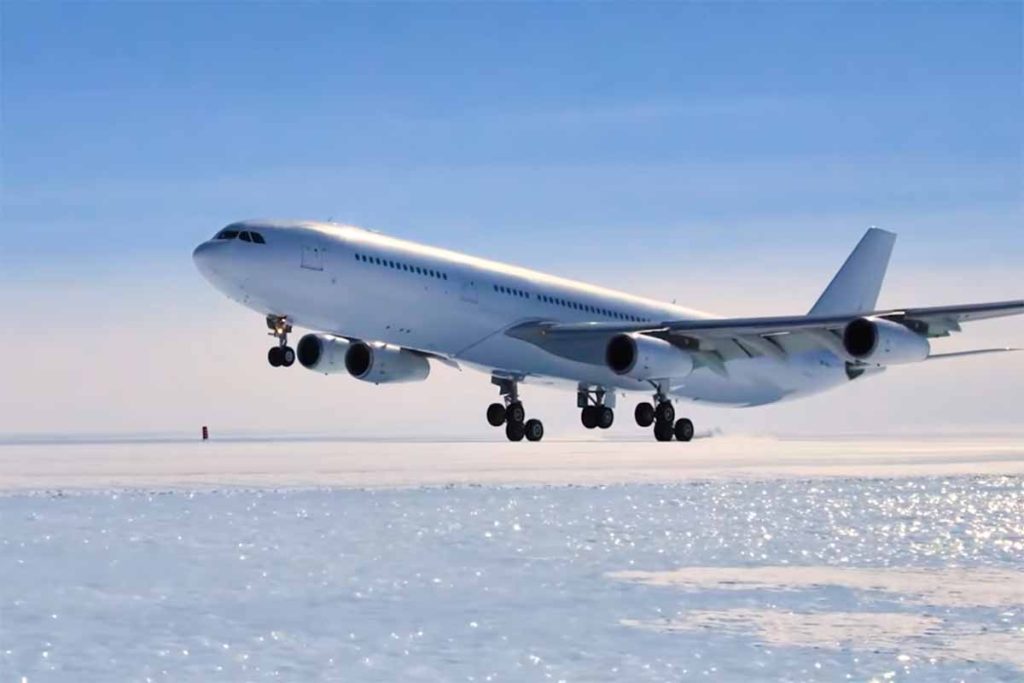After traveling 2,500 nautical miles (4,300 km) in just over five hours from Cape Town, Hi Fly’s A340-313 with registration number 9H-SOL made history by becoming the first four-engine Airbus family aircraft to land in Antarctica.
As detailed by the company, this season this plane will be used to transport a small number of tourists to the frozen continent, along with scientists and essential goods.
The company celebrated this achievement in a number of ways, including sharing a travel diary, written by company owner and pilot Carlos Merbury (which you can read below). And if a picture is worth a thousand words, not to mention an HD video showing every angle of this historic journey.
The video is available below (wait for the upload).
Commander’s Diary
Hi Fly 801/802 – November 2, 2021
The crew was assembled and left the Cape Town hotel at 5am local time. Transfer took 30 minutes to the airport. The paperwork took another 30 minutes and we got on the plane at 6am, two hours before our scheduled departure time.
The engineers and ground operations personnel had left the hotel an hour earlier, so by the time we got to the plane, refueling and loading of goods had been completed. We were expecting 23 passengers, all customer staff, and since this was the first flight of the season, most of the ground support equipment we would need at WFR (Wolf’s Fang Runway, Antarctica) was in our cargo hold. The sole purpose of the first two rounds is to establish the operation in Antarctica, before the summer of 2021/2022.

The 2,500 nautical miles distance between CPT and WFR takes 5 hours 10 meters on the way and 5 hours and 20 meters on the way back. Since this was our first flight, with limited ground support, we planned a 3 hour layover at WFR. It was going to be a long day for the crew, but the excitement of participating in such a unique event was above all else.
As usual, we start briefly as soon as we get on the plane. This is not just another flight, there are details regarding this very remote operation that we were going to take, the hostile environment we will be facing and the need to ensure that appropriate protective clothing is available on board.
While conducting cabin and catering checks, my crew and I searched the aircraft, checked its systems, loaded the route into the navigation computers, and reported our departure details.
Passengers arrived 20 minutes before the scheduled departure time. It was exactly eight in the morning local time when we left the gate. Always punctuality. This is High Fly’s logo.
We lined up on runway 01, but had to stop for a moment before take off; It detected heavy bird activity on the track and asked the turret to rotate the truck in charge of it away, eventually turning away from the road. The last thing we want is for a jumper to damage the engine on any flight. At 8:19 AM, we were finally on the air. Beautiful morning in Cape Town and great views.
There is no fuel in WFR. Carrying 77 tons of fuel in South Africa, the 9H-SOL is an A340-313HGW (High Gross Weight) aircraft with a maximum take-off weight of 275 tons. It is a robust, comfortable and safe aircraft, and performs well in this environment. Its 4 engine redundancy and long range make it the ideal aircraft for this type of mission.
The road to WFR was almost straightforward, after complying with the exit procedure permit issued by Cape Town Air Traffic Control. We were soon delivered to FIR Oceânica Johannesburg via CPDLC/ADS, thus avoiding the cumbersome long range high-frequency communication dating back to the 1950s. Digital communication is the norm today in most areas of aeronautics. We lost our data link connection just 250 miles before WFR. But, about 180 miles from the destination, we were able to get to Wolf’s Fang by VHF. It’s not air traffic control, just someone with a portable radio watching the runway. And in fact, they take good care of your condition.
To the south, we return to polar navigation techniques, using the real address as a reference.
The graph is also used to make sure we don’t get off track. During the route we received via ACARS (Another Digital Communication System), the frequent weather reports from WFR that are sent to us through our Lisbon operations.
WFR personnel own an Iridium satellite telephone, the only means of communication in this part of the world. Meteorologists do a great job, and we only get to Antarctica when the weather meets our needs. But one thing is for sure that when traveling to the end of the world, you often need to make sure that the actual time matches the forecast.
The weather looked great and as we neared the landing we should also be getting runway friction reports. This is measured with a properly equipped vehicle, which travels the entire length of the track taking measurements every 500 metres. Friction was also above all we considered a minimum, so we started the descent.

Carrying fuel to cover both tracks means we’ll land a maximum weight of 190 tons. If we add the fact that we operate from an airport carved out of icy blue ice, it is easy to understand that the first landing of an Airbus A340 at that location attracted a lot of interest and concern. But in the main office, we were sure that we did our homework well.
Our operations department conducted several months of preparation for this flight and the success of our first landing is testament to the good work that has been done.
There was even a visit to the WFR, on a commercial airliner carrying scientists, two days before our flight, by Captain Antonius Efthimiou.
The blue ice rink is tough. Heavy aircraft can be supported in it. Its depth is 1.4 km of free air ice. And most importantly, the colder the better. grooves along the track were carved with special equipment, and after cleaning and carving, a suitable braking coefficient is obtained; Since the runway is 3,000 meters long, landing and stopping such a heavy A340 at that airport would not be a problem. At least not on paper, as the A340 has never landed on blue ice before.

The reflection is massive and the right glasses help to adjust your eyes between outside vision and the devices. The pilot who is not in command has an important role in issuing the usual warnings, as well as additional warnings, especially in the final stages of the approach.
The runway is not easy to see, but at some point we should see it, since in WFR there is absolutely no navigational assistance and at about 20 miles we should be in eye contact.
We finally got a glimpse of the runway alignment and started setting up early, choosing the flaps and landing gear to be installed exactly 10 miles ahead of the runway. There is also no visual guide to the slope, and the path’s blending with the surrounding terrain and the vast white desert surrounding it makes judging the elevation tricky, to say the least.
Cold weather altimeters also suffer from temperature errors and need adjustment. All this was taken into account. We took a smooth approach and the aircraft worked just as expected. When we got to the taxi speed, I heard a round of applause in the cab. We were happy. After all, we were writing history.
The downtime was much less than the expected three hours. Our flights and ground operations have done an excellent job, as have our engineers. A real winning team. Equipped for the extreme cold, we ventured outside, greeted people, and saw track details and angles for added confidence in the system in place. All seems well to start frequent operations to and from Antarctica.
The take-off was quiet, and so was the return flight. The customer was happy, and we were happy. All objectives of this first flight were achieved. The event was recorded by our reporter Mark Boe.

“Music fanatic. Professional problem solver. Reader. Award-winning tv ninja.”



![[VÍDEO] Elton John’s final show in the UK has the crowd moving](https://www.tupi.fm/wp-content/uploads/2023/06/Elton-John-1-690x600.jpg)


More Stories
A South African YouTuber is bitten by a green mamba and dies after spending a month in a coma
A reptile expert dies after a snake bite
Maduro recalls his ambassador to Brazil in a move to disavow him and expand the crisis